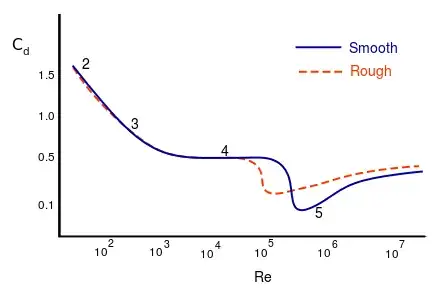The drag coefficient $C_D$ is not constant for a sphere - setting it equal to 0.5 is a convenient shortcut. The actual relationship is complex, as demonstrated by the following plot (from http://www.wikiwand.com/en/Drag_coefficient)

This shows the drag coefficient varies quite a lot with Reynolds number, which itself is given by
$\rm{Re}=\frac{\rho v \ell}{\mu}$$
Where $\rho$ is the density, $v$ the velocity, $\ell$ a "typical length scale" (the diameter in case of a sphere) and $\mu$ the dynamic viscosity.
As you can see, $\rm{Re}$ is a function of $v$ - so there may not be a closed form solution. Instead you might start with the quadratic drag expression, assume a $C_D$ of 0.5, and compute $v$. You then calculate $\rm{Re}$, use it to get a better estimate for $C_D$, and repeat... If you end up at very small Reynolds numbers you may want to try the linear (Stokes) drag instead - there is no well defined transition between the two equations.
The key point is this: the laminar (Stokes) equation is only valid for very small Re: so if you end up calculating a terminal velocity where Re is not so small, then you should probably repeat the calculation with the quadratic expression. Only when the result is self-consistent do you know you have done it right.
So yes - the two expressions are both valid (in their own way) and they give different results. Caution is needed - but in general very small particles tend to have laminar flow and follow Stokes' law, while big ones are turbulent. The exact transition between the two is not easy to define.
You may find it instructive to try to plot the terminal velocity for a particle by changing its density and thus the force - and to do so for both equations. It would require you to create a lookup table for the drag coefficient but it's an exercise that would give you more insight into this kind of behavior than you would get if I just did the work for you.

